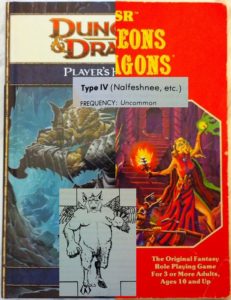There has recently been another round of discussion about associative and dissociative mechanics. Here is Justin Alexander’s restatement of his original thesis, a post by Zak about diegetic and extradiegetic thinking, Carter Soles on healing surges, and Jeff on whether or not the d30 rule is dissociated. Zak doesn’t use the words “associated” or “dissociated” anywhere, but it’s really the same issue from a different angle. Are players reasoning about cause and effect within the game world or within the structure of the rules?
Consider two examples:
- The Labyrinth Lord spell “levitate” (LL page 33):
For a number of turns equal to the casters level +6 turns, the caster can move up and down as he wishes. The caster mentally directs movement up or down as much as 20 feet each round. The caster cannot move horizontally, but could clamber along the face of a cliff, for example, or push against a ceiling to move laterally (generally at half base land speed).
- The Fourth Edition level seven fighter power “come and get it” (4E Player’s Handbook page 80):
Every enemy (but not ally) within a 15 foot radius is shifted two squares (10 feet) and become adjacent to you do so, and then you get to make a weapon vs. AC attack against them.
In the first example, the meaning is primary. The caster is no longer subject to the limitations of gravity, and can move themselves around at some set speed. In the second example, the effect is primary. Enemies come to the PC to be hit. We don’t know why. Did the PC taunt the enemies? Did the PC lasso the enemies? Either might make sense in different cases, and many people don’t bother at all with narrative explanations. Obviously, it is not an either/or thing, but one of association or dissociation is usually dominant. In the first example, the duration in turns is somewhat dissociated (why would levitation only be available in game-convenient durations that are a multiple of ten minutes?), but unobtrusively so.
The common example of a limited martial resource (such as a daily power) as a dissociated mechanic is really just a special case of this more general “meaning first” or “effect first” principle. It is easier to make a balanced game using effect first design, which is why 4E leans so heavily on dissociated mechanics, as mathematical balance was an important goal for that system.
The examples above also show how this issue is orthogonal to realism. Levitating is obviously not realistic (at least based on my experience), but it is associated. Enemies moving toward you and then you hitting them is realistic, but it is dissociated. Why are they moving toward you? Why do you as a player have the ability to affect the movement of your enemies? You can come up with an after the fact narrative explanation, but the meaning is secondary and the effect is primary.
As has been noted in some of the links above, there are some dissociated mechanics in traditional D&D too. Hit points and experience points are notable. To elaborate, the effects of gaining a level are primary (more staying power, additional spell capability, followers, whatever), and the narrative explanation is after the fact. Was the PC training? Did a demon grant them extra power? We often don’t know. HP and damage are probably the most problematic. How can cure light wounds help with the loss of luck and fatigue? We can come up with an explanation, but it’s certainly not obvious. Weapon and armor restrictions are another common dissociated irritant that has prompted many house rules, my own included (see here for weapon damage by hit die and a system to do away with armor restrictions).
The major difference, as I see it, in how new school games and old school games do things is that the dissociated mechanics of old school games affect encounter-based problem solving less than they do in new school games. And when they do affect problem solving (perhaps equipping every character in OD&D with daggers because they are cheaper and all weapons do 1d6 damage) that is considered pathological, and either fixed with house rules or condemned as against the spirit of the game. From the standpoint of creative problem solving, if meaning is first, the potential effects are limitless, and this is in my opinion why many people are uncomfortable with the extensive use of effect-first mechanics.
Edit: I’m sure this post was influenced by On the Failure of Tactical Combat over at Hack & Slash (though his post focuses, unsurprisingly, more on combat). So go read that too.

